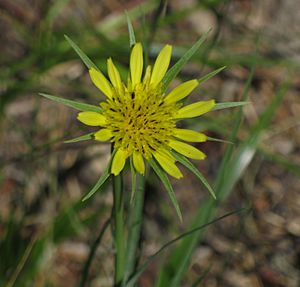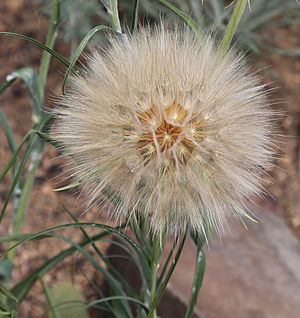Yellow salsify facts for kids
Quick facts for kids Yellow salsify |
|
|---|---|
 |
|
| Scientific classification | |
| Genus: |
Tragopogon
|
| Species: |
dubius
|
Tragopogon dubius, often called yellow salsify or western salsify, is a type of plant. It is also known by many other names like western goat's-beard or wild oysterplant. This plant originally comes from southern and central Europe, and western Asia. You can find it as far north as France.
Western salsify has also spread to North America. It is now common across most of the United States and Canada.
Contents
What Does Western Salsify Look Like?
Western salsify is usually an annual plant, meaning it lives for one year. Sometimes, it can be a biennial plant, living for two years. It typically grows to be about 20 to 60 centimeters tall. Some plants can even reach almost a meter!
This plant likes warm, sheltered places with moist soil. Its bright yellow flower head is about 4 to 6 centimeters wide. You can usually see these flowers in late spring or early summer. The flower buds are blue-green, tall, and pointed. The flowers open in the early morning and often close by late afternoon.
Seed Heads and Seeds
Later, the plant forms a large seed head. It looks a lot like a dandelion seed head, but it is much bigger. The seeds themselves are called achenes. They are 2 to 4 centimeters long but are very light, weighing only about 8 milligrams each.
Some seeds in the center of the head are a bit different from those on the edges. The seeds on the edges are usually darker and heavier. They also have more special chemicals that might help them survive better.
How Is Western Salsify Different from Other Plants?
Western salsify looks quite similar to another common plant called meadow salsify (T. pratensis). However, western salsify has longer and more noticeable bracts. Bracts are like small leaves that grow behind the flower head. These are a special feature of salsify plants.
Even though western salsify is not very closely related to meadow salsify or common salsify (T. porrifolius), they can easily mix their genes. In North America, these mixed plants have even created new types of hybrid species! These new species are called T. mirus and T. miscellus.
Other Names for Western Salsify
Because western salsify is found in many places, it has many different common names. Some of these include western goat's beard, wild oysterplant, yellow salsify, yellow goat's beard, and common salsify. It's good to know that some of these names are also used for other plants.
Sometimes, you might also see it called Tragopogon major. This is an older scientific name for the plant.
Can You Eat Western Salsify?
Yes, parts of the western salsify plant can be eaten! The leaves at the bottom of the plant can be eaten raw or cooked.
Native Americans used to eat the roots of this plant. The roots are best when cooked. People say they taste a bit like oysters!
See also
 In Spanish: Tragopogon dubius para niños
In Spanish: Tragopogon dubius para niños


